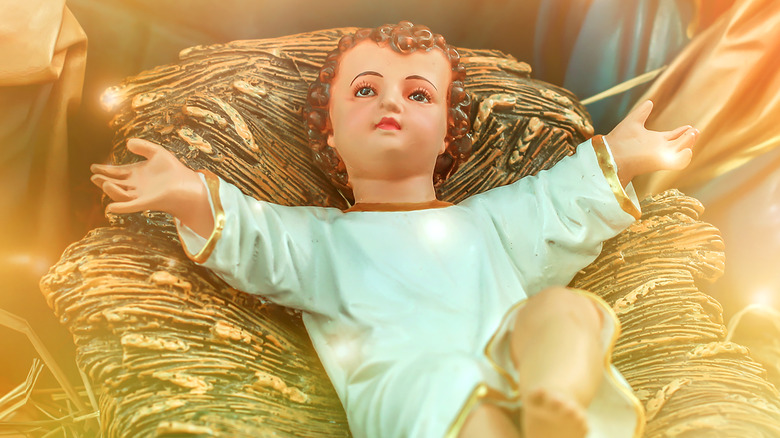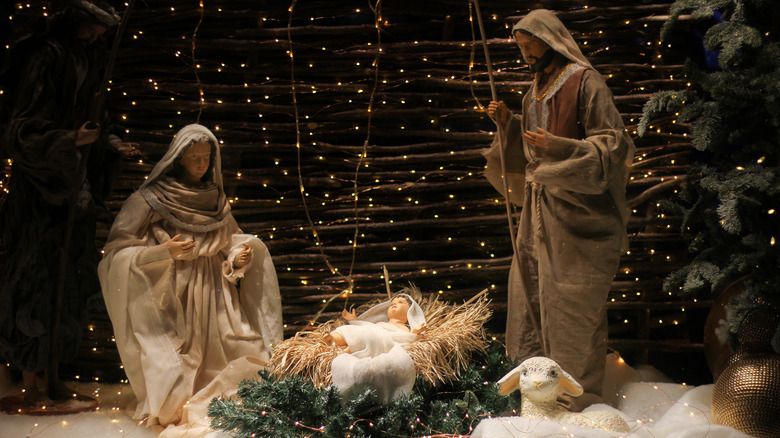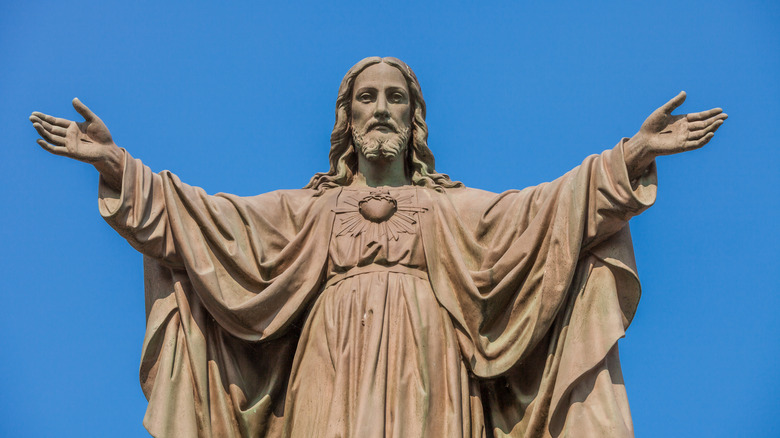Your Nativity Scene Probably Isn't Accurate. Here's Why
Part of the Christmas fun is going around to see which neighbor went full-on Clark W. Griswold with the lights, which one tried to top last year's offensive inflatable reindeer (via Rare), and which one stuck a wreath on the door and decided to call it done. But nothing gets a little neighborhood competition going like a nativity scene to see who can have the biggest, brightest, and fullest display. In recent years, though, people have broken free from the traditional nativity scene of Jesus, Mary, and Joseph, and instead opt for nativities featuring characters from "Star Wars," "Batman," or rubber duckies. Others go a totally different route by building their own out of Spam or cupboard snacks, per Metro.
As blasphemous as some may consider it to be to take such artistic license in depicting the birth of Jesus, as it turns out, the traditional nativity scene isn't completely accurate either. Who was there, how they got there, and the very surroundings: much of it is contradicted in the Bible. What we see in the traditional nativity scene is the result of some combination of the gospel, folklore, and religious traditions — centuries of speculation, people trying to fill gaps in knowledge, and certainly some artistic interpretation.
There probably wasn't a stable full of animals
Setting the scene of Jesus born under the night sky only lit by the bright Star of Bethlehem and surrounded by the holy family, wise men, and animals representing all life, is an important part of Christmas lore. Unfortunately, it's almost certainly wrong, no matter how many times it's sung in Christmas carols. One Bible passage describes the journey Mary and Joseph take to Bethlehem to participate in a mandated census. However, there "was no room for them in the inn." But as The Atlantic points out, something gets lost in the translation of the word "inn." That's no hotel; it's more like guest quarters for visitors. While the Bible does say that Jesus was laid in a manger, it's more like the lower level of a house where animals were brought in to keep them safe at night.
As far as the animals are concerned, a lot of assumptions are made. Nativities put sheep with the shepherds and camels with the wise men. But there's no evidence for it — something even Pope Benedict XVI admitted in his book "Jesus of Nazareth: The Infancy Narratives, writing," "In the gospels there is no mention of animals." So, if animals were there the night Jesus was born, there's no record of which ones.
About those three kings
As it turns out, we don't actually know that there were three men, and we don't know they were kings. The Bible never says how many "Magi" there were. It only says three gifts — gold, frankincense, and myrrh — were given to Jesus. Those three led to a leap that there were three wise men. The wise men have come to be known as Caspar, Melchior, and Balthazar, but that wasn't in the Bible. It was found in a Greek manuscript 500 years after the birth of Jesus. "They're astrologers, wise men, priests from somewhere outside the Roman Empire. That's all we're really told so, yes, 'the three kings with the one from Africa' — that's legend; it works quite well as legend," Archbishop of Canterbury Dr. Rowan Williams told the BBC in 2007.
And, according to many biblical scholars, it's more likely the wise men weren't present at the birth of Jesus. Instead, they arrived weeks or months (as much as two years, by some estimates) after his birth, per the National Museum of American History. According to the Gospel of Matthew (via Bible Hub), they visited "the young child" in a "house. ... And when they had come into the house, they saw the young child with Mary his mother."
In that place and at that time, Jesus couldn't have been white
The inaccuracy of most nativity scenes in the U.S. that has had the most enduring negative effect is the complexion of the holy family. In most cases, Jesus, Joseph, and Mary have fair skin, blue eyes, rosy-red cheeks, and (in some cases) blond hair. That's a product of 19th-century America, according to Edward Blum, San Diego State University religion professor and co-author of "The Color of Christ," who told The Washington Post that evangelical Protestants ran with a fake letter that "depicted [Jesus'] face as warm with some redness to his cheeks." The fraudulent letter is also where depictions of Jesus having long, parted hair comes from. "In the early 19th century, American Protestants fell in love with it," said Blum.
However, some are willing to let the ethnicity and experience of Jesus be in the eye of the beholder. "We want particularly our children to understand that they can experience God out of their own experience," Rev. Christine Wiley, pastor of Washington's Covenant Baptist United Church of Christ, said to The Washington Post. "So they shouldn't have to see God as the 'other.' They don't have to see God as a long-haired, blued-eyed person."



